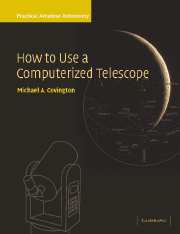Book contents
- Frontmatter
- Contents
- Preface
- Part I Telescopes in general
- 1 Welcome to amateur astronomy!
- 2 How the sky moves
- 3 How telescopes track the stars
- 4 Using equatorial mounts and wedges
- 5 Telescope optics
- 6 Eyepieces and optical accessories
- 7 Astrophotography
- 8 Troubleshooting
- Part II Three classic telescopes
- Index
4 - Using equatorial mounts and wedges
Published online by Cambridge University Press: 10 February 2010
- Frontmatter
- Contents
- Preface
- Part I Telescopes in general
- 1 Welcome to amateur astronomy!
- 2 How the sky moves
- 3 How telescopes track the stars
- 4 Using equatorial mounts and wedges
- 5 Telescope optics
- 6 Eyepieces and optical accessories
- 7 Astrophotography
- 8 Troubleshooting
- Part II Three classic telescopes
- Index
Summary
Why equatorial?
Table 4.1 sums up the advantages and disadvantages of equatorial and altazimuth mounts.
There are two main reasons for using an equatorial mount (such as the one in Figure 4.1): to eliminate field rotation (Figure 4.2) in long-exposure photography, and to establish which way is north in the sky so that you can use charts and measure double-star position angles. Apart from that, altazimuth mode is almost always preferable. Setup is simpler and quicker, and you don't need an equatorial wedge to tilt the base.
There is one situation in which an equatorial mount is easier to set up than an altazimuth one. That is when you have a permanent telescope stand that is accurately aligned with the Earth's axis. In that case, all you have to do is attach the telescope and sync on one star. That's all – the telescope is aligned, calibrated, and ready for both visual observing and photography.
Must field rotation be eliminated?
Equatorial mounts get rid of the field rotation illustrated in Figure 4.2. Celestial objects tilt as they rise, travel across the sky, and set. An equatorially mounted telescope tilts with them, so that everything remains stationary in the field of view, but altazimuth-mounted telescopes suffer field rotation. With an altazimuth mount, the object that you're tracking remains centered, but everything else rotates around it.
- Type
- Chapter
- Information
- How to Use a Computerized TelescopePractical Amateur Astronomy Volume 1, pp. 39 - 58Publisher: Cambridge University PressPrint publication year: 2002

